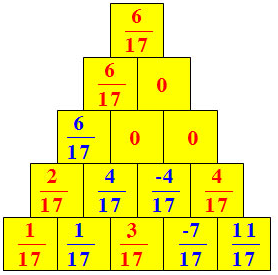
Hãy nhập câu hỏi của bạn vào đây, nếu là tài khoản VIP, bạn sẽ được ưu tiên trả lời.



Các kết quả trên đều đúng nên mình điền luôn kết quả nha bạn:
(36,05+2678,2)+126=2840,25.
(126+36,05)+13,214=175,264.
(678,27+14,02)+2819,1=3511,39.
3497,37-678,27=2819,1.
Đó là kết quả của mình có gì sai thì mog pn chỉ ra và giúp mik sửa lỗi nhé!
- Các phép cộng đều cho kết quả đúng.
- Ta có:
(36,05 + 2678,2) + 126
= 36,05 + (2678,2 + 126) (Tính chất kết hợp)
= 36,05 + 2804,2 (theo a)
= 2840,25 (theo c)
(126 + 36,05) + 13,214
= 126 + (36,05 + 13,214) (tính chất kết hợp)
= 126 + 49,264 (theo b)
= 175,264 (theo d)
(678,27 + 14,02) + 2819,1
= (678,27 + 2819,1) + 14,02 (Tính chất giao hoán và kết hợp)
= 3497,37 + 14,02 (theo e)
= 3511,39 (theo g)
3497,37 – 678,27 = 2819,1 (suy từ e)
Vì vậy ta có thể điền số thích hợp và ô trống mà không cần tính toán:

\(\Rightarrow\dfrac{5}{4}-\dfrac{1}{4}x=\dfrac{3}{10}x-\dfrac{2}{5}\)
\(\Rightarrow\dfrac{5}{4}+\dfrac{2}{5}=\dfrac{3}{10}x-\dfrac{1}{4}x\)
\(\Rightarrow\dfrac{33}{20}=\dfrac{11}{20}x\)
\(\Rightarrow x=\dfrac{33}{20}\div\dfrac{11}{20}\)
\(\Rightarrow x=3\)
\(1\dfrac{1}{4}-x\dfrac{1}{4}=x\cdot30\%\cdot\dfrac{2}{5}\)
\(\Leftrightarrow\dfrac{5}{4}-x\dfrac{1}{4}=x\cdot\dfrac{3}{10}-\dfrac{2}{5}\)
\(\Leftrightarrow\dfrac{5}{4}-\dfrac{1}{4}x=\dfrac{3}{10}x-\dfrac{2}{5}\)
\(\Leftrightarrow25-5x=6x-8\)
\(\Leftrightarrow-5x-6x=-8-25\)
\(\Leftrightarrow-11x=-33\)
\(\Leftrightarrow x=3\)
Vậy x = 3

Chiều rộng mặt kênh tăng lên: \(135-58=77m\)
Chiều rộng đáy kênh tăng lên: \(50-22=28m\)
Độ sâu của kênh tăng lên: \(13-6=7m\)
Thời gian tàu qua kênh giảm bớt: \(48-14=34h\)
Hành trình Luân Đôn - Bom-bay giảm bớt: \(17\text{ }400-10\text{ }100=7300km\)
Hành trình Mác-xây - Bom-bay giảm bớt: \(16\text{ }000-4\text{ }400=8600km\)
Hành trình Ô-đét-xa - Bom-bay giảm bớt: \(19\text{ }000-6\text{ }800=12200km\)

Tớ rất cảm phục bạn vì trả lời tớ nhanh như thế, nhưng 4 phân số Ai Cập KHÁC NHAU kia mà

Làm theo quy tắc ở hình 10, ta có thể "xây tường" như sau:

\(A=3+\dfrac{3}{2}+\dfrac{3}{2^2}+....+\dfrac{3}{2^9}\)
\(2A=2\left(3+\dfrac{3}{2}+\dfrac{3}{2^2}+....+\dfrac{3}{2^9}\right)\)
\(2A=6+3+\dfrac{3}{2}+...+\dfrac{3}{2^8}\)
\(2A-A=\left(6+3+\dfrac{3}{2}+...+\dfrac{3}{2^8}\right)-\left(3+\dfrac{3}{2}+...+\dfrac{3}{2^9}\right)\)
\(A=6-\dfrac{3}{2^9}\)
Đặt A=3+3/2+3/2^2+...+3/2^9
A=3.(1/2+1/2^2+...+1/2^9)
Đặt B=1/2+1/2^2+...+1/2^9
=>B.2=1+1/2+1/2^2+...+1/2^8
=>2B-B=(1+1/2+...+1/2^8)-(1/2+1/2^2+...+1/2^9)
=>B=1-1/2^9
=>B=512/512-1/512
=>B=511/512
=>A=3.511/512
=>A=1533/512
Vậy A=1533/512

Câu 14)
\(a,\\ =-\dfrac{3}{8}+\dfrac{8}{17}+\dfrac{-5}{8}-\dfrac{3}{5}+\dfrac{9}{17}\\ =\left(\dfrac{-3}{8}+\dfrac{-5}{8}\right)+\left(\dfrac{8}{17}+\dfrac{9}{17}\right)-\dfrac{3}{5}\\ =\left(-1\right)+1-\dfrac{3}{5}=0-\dfrac{3}{5}=\dfrac{-3}{5}\\ b,\\ =\dfrac{7}{15}.\dfrac{-15}{14}+\left(\dfrac{27}{16}-\dfrac{1}{8}\right):\dfrac{5}{8}\)
\(=\dfrac{-1}{2}+\dfrac{25}{16}.\dfrac{8}{5}=\dfrac{-1}{2}+\dfrac{5}{2}=2\\ c,\\ =\dfrac{2}{2}-\dfrac{2}{3}+\dfrac{2}{3}-\dfrac{2}{4}+.....+\dfrac{2}{99}-\dfrac{2}{100}\\ =1-\dfrac{1}{50}=\dfrac{49}{50}\)
Câu 15
\(a,2x+\dfrac{-1}{4}=\dfrac{3}{2}\\ 2x=\dfrac{3}{2}-\dfrac{-1}{4}=\dfrac{7}{4}\\ x=\dfrac{7}{4}:2=\dfrac{7}{8}\\ b,\dfrac{15}{x}=\dfrac{-3}{4}\\ x=\dfrac{15.4}{-3}=-20\)














Bài 1:
a) \(\dfrac{1}{2}+\dfrac{1}{4}=\dfrac{3}{4}\)
b) \(\dfrac{1}{2}+\dfrac{1}{3}=\dfrac{5}{6}\)
c) \(\dfrac{1}{5}+\dfrac{1}{6}=\dfrac{11}{30}\)
Bài 2:
a) \(\dfrac{1}{6}+\dfrac{1}{3}+\dfrac{1}{12}=\dfrac{7}{12}\)
b) \(\dfrac{1}{15}+\dfrac{1}{30}+\dfrac{1}{3}=\dfrac{13}{30}\)